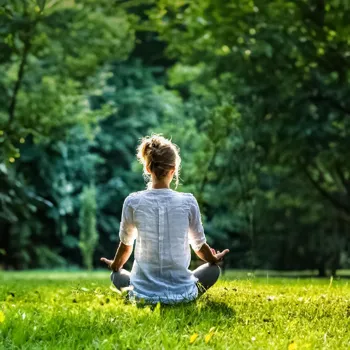Discover the transformative power of mindfulness in improving mental well-being. Learn how mindfulness practices can enhance your life
In today's fast-paced world, where deadlines loom and stress seems
to be a constant companion, finding moments of peace can feel like a distant dream.

But what if I told you that a simple practice, readily available and requiring no special equipment, could dramatically improve your mental well-being? This practice is called mindfulness, and it's gaining immense popularity for its transformative effects on the mind.
Mindfulness isn't about emptying your mind, it’s about paying attention to the present moment, without judgment. Understanding the power of mindfulness, it becomes easier to imbibe in our lives.
Mindfulness involves focusing on your thoughts, feelings, and sensations as they arise, without getting carried away by them. It's like observing a river flowing by – you watch the water move, the sunlight glinting on the surface, but you don't jump in and get swept away by the current.
This awareness allows you to create space between yourself and your reactions, giving you more control over your emotions and behavior. In essence, mindfulness is a powerful tool for cultivating inner peace and resilience in a world that often feels chaotic.
Practicing mindfulness regularly has been shown to offer a wide range of benefits, impacting everything from mental health to physical well-being. Studies have demonstrated its effectiveness in reducing stress, anxiety, and depression.
By focusing on the present moment, you lessen the tendency to dwell on the past or worry about the future, both of which contribute significantly to mental distress. Moreover, mindfulness can improve your focus and concentration, making you more productive at work or school.
A calm and focused mind is better equipped to handle challenges and navigate complex situations.
Beyond mental health, mindfulness can also have a positive impact on your physical health. It has been linked to lower blood pressure, improved sleep quality, and even a strengthened immune system.
When you're less stressed and more present, your body functions more efficiently. This holistic approach to well-being makes mindfulness an attractive option for individuals seeking to improve their overall quality of life.
It's a natural and accessible way to promote health and happiness from the inside out.
In this article, we'll explore ten practical mindfulness exercises you can easily incorporate into your daily routine.
These practices are designed to help you become more aware, present, and centered, allowing you to navigate life's challenges with greater ease and resilience.
Remember, consistency is key – even just a few minutes of mindfulness each day can make a significant difference in your overall well-being. It's about making mindfulness a habit, a part of your daily life, just like brushing your teeth or taking a walk.
Start small, be patient with yourself, and enjoy the journey of self-discovery that mindfulness offers.
So, lets dive in and explore these 10 practices that can transform your life.
Mindful Breathing:
This is the cornerstone of many mindfulness practices. Find a comfortable position, close your eyes (or keep them softly focused), and bring your attention to your breath. Notice the sensation of the air entering and leaving your body. Feel your abdomen rising and falling with each breath.

When your mind wanders (and it will!), gently guide your attention back to your breath. Start with just a few minutes each day, gradually increasing the duration as you become more comfortable. You can do this sitting, lying down, or even walking.
The key is to keep your focus on the breath, using it as an anchor to the present moment. Remember, there's no right or wrong way to breathe, just notice the natural rhythm of your breath. This is a simple yet powerful way to calm your mind and reduce stress throughout the day.
Body Scan Meditation:
Lie down comfortably and close your eyes. Bring your attention to your toes and notice any sensations – tingling, warmth, pressure, or simply the feeling of your socks.
Slowly move your attention up your body, paying attention to each part – your feet, ankles, calves, thighs, hips, abdomen, chest, fingers, hands, arms, shoulders, neck, and head. Acknowledge any sensations you feel, without judgment.
If you notice any pain or discomfort, simply observe it without trying to change it. This practice helps you become more aware of your body and release tension. It also helps you connect with your physical self and accept your body as it is.
It is also a fantastic way to get in touch with the physical state of the things happening internally.
Mindful Walking:
Instead of rushing from one place to another, try walking mindfully. Pay attention to the sensation of your feet making contact with the ground. Notice the movement of your body as you walk, the feeling of the air against your skin, and the sights and sounds around you.

Let go of any thoughts about where you're going or what you need to do. Simply be present in the moment, experiencing the act of walking. This is a great way to incorporate mindfulness into your daily routine.
You can do this on your way to work, during a lunch break, or even just walking around your home. Mindful walking also brings in more awareness about your physical self.
Mindful Eating:
We often eat without paying attention, quickly consuming our food while distracted by our phones or the television. Mindful eating involves slowing down and savoring each bite. Pay attention to the colors, textures, and aromas of your food.
Chew slowly and deliberately, noticing the flavors and sensations in your mouth. Put down your fork between bites and take a moment to appreciate your food. This practice can help you develop a healthier relationship with food and prevent overeating.
It also adds pleasure to the act of eating and enables you to taste food properly. More so, you get to savor each flavor like never before.
Mindful Listening:
In conversations, we're often thinking about what we're going to say next, instead of truly listening to the other person. Mindful listening involves giving your full attention to the speaker, without interrupting or judging.
Pay attention to their body language, tone of voice, and the emotions behind their words. Try to understand their perspective, even if you don't agree with it. This practice can improve your relationships and enhance your communication skills.
By truly listening, you can connect with others on a deeper level and gain a greater understanding of the world around you.
Gratitude Journaling:
Take a few minutes each day to write down things you're grateful for. These can be big or small – your health, your family, a beautiful sunset, or a delicious cup of tea. Focusing on gratitude shifts your attention away from negativity and helps you appreciate the good things in your life.

It's a powerful way to boost your mood and cultivate a more positive outlook. You can write in a physical journal, use a digital app, or simply reflect on the things you're grateful for in your mind. The important thing is to make it a regular practice.
Loving-Kindness Meditation:
This practice involves sending feelings of love, kindness, and compassion to yourself and others. Start by thinking of someone you care about and silently repeating phrases like, "May you be happy, may you be healthy, may you be safe, may you be at peace.

" Then, extend those feelings to yourself, to your friends and family, to acquaintances, to neutral people, and even to people you dislike. This practice cultivates empathy and reduces feelings of anger and resentment. It also can make you more compassionate towards others.
Regular practice even has been shown to make you more understanding.
Mindful Observation:
Choose an object or a scene – a flower, a tree, a painting – and observe it closely. Pay attention to the details you wouldn't normally notice. What are the colors, shapes, textures, and patterns? Engage your senses and fully immerse yourself in the experience of observation.

This practice enhances your awareness and appreciation of the world around you. Additionally, you learn a new skill of observation for life. This helps in noticing new attributes of things around you which you would normally ignore.
Technology Detox:
Designate specific times each day to disconnect from technology – your phone, computer, TV, and social media. Use this time to engage in other activities that bring you joy and relaxation, such as reading, spending time in nature, or connecting with loved ones.

This practice helps you reduce stress and reclaim your attention. Being constantly connected can be overwhelming. Make sure you take regular breaks to disconnect. These breaks can be extremely beneficial.
Mindful Chores:
Even everyday tasks like washing dishes, doing laundry, or cleaning the house can be opportunities for mindfulness.

Instead of rushing through these chores, pay attention to the sensations involved – the feeling of the water on your hands, the smell of the detergent, the sound of the washing machine. Focus on the present moment and let go of any distractions.
This practice transforms mundane tasks into opportunities for mindfulness and helps you appreciate the simple things in life. It's an opportunity to connect with your surroundings and make the most of every activity.
Incorporating these ten practices into your daily life can lead to a healthier, happier, and more fulfilling existence. Remember to be patient with yourself, start small, and celebrate your progress along the way. Mindfulness is a journey, not a destination.











